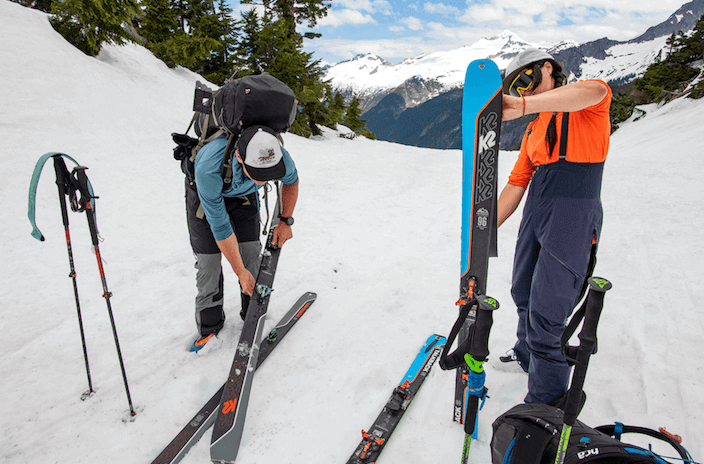Cart
You have no items in your shopping cart

Climbing skins are strips of fabric that attach to the bottoms of your backcountry skis to allow you to climb up hills with the skis on your feet. Most skins attach to skis with tip loops, tail clips and sticky glue. Once you reach the top of the hill, peel the skins off, fold them in half, stuff them in your bag and enjoy the ride back down.
There are several factors to consider when choosing climbing skins, such as material, width and length. It’s also important to understand how to trim skins to precisely fit the width and length of your skis and how to attach the skins to your skis.
Shop GearHub’s selection of climbing skins.
In the old days, climbing skins were made from seal skin (hence the name). Today, skins are made from synthetic material, mohair (hair from Angora goats) or a blend of the two. The difference in skin material plays a significant role in traction, glide, durability and cost.
Synthetic skins are typically made of nylon. Nylon is very durable and provides superb traction, but tends to not glide as well as mohair. Nylon skins are usually less expensive than mohair or mohair-blend skins.
Less common than nylon skins are skins made from polyethylene plastic. These skins mimic the design and function of the traction pattern found on waxless cross-country skis. In general, they glide very well but do not provide the same level of traction as nylon skins.
Mohair skins provide a good mix of grip and glide and are lightweight. They are less durable and more expensive than nylon.
Blend skins combine nylon and mohair together. They provide a good compromise of grip, glide, weight, durability and cost.
Consider your use when choosing materials. If you’re a regular backcountry skier who sets out on long-distance tours, go with skins that are lightweight and offer better glide. If you only occasionally backcountry ski or are new to the sport, save some money and choose nylon skins for their durability and excellent grip.
Shop GearHub’s selection of climbing skins.
Most skins are sold in 5mm increments from about 80mm – 145mm wide. Wider skins cover more of your ski base, which results in better traction. Naturally, the opposite is true of skinnier skins. Most backcountry skiers choose skins for maximum base coverage to get the best grip.
To achieve maximum base coverage: Take the widest dimension of your ski (usually at the tip) and subtract about 5 – 7mm. This will give you a skin width that covers nearly the entire base of your ski after you trim them to match the shape of your ski with the included tool.
For example, if your ski dimensions are 132/105/116mm, buying skins that are 125mm wide will provide excellent coverage throughout the entire ski. Wider skins are more expensive, so you’ll pay more for maximum coverage, but you’ll have excellent grip going uphill.
To minimize weight: For some backcountry skiers, weight is of the utmost importance and one way to lighten the load is to go with skinnier skins. If weight is a serious concern of yours, you may want to choose a skin that closely matches the waist dimension of your ski without covering the metal edges.
For example, if your ski dimensions are 121/95/109mm, choose skins that are 90mm wide. Sizing skins based on the waist dimension will sacrifice some traction so you may not be able to climb as steeply as you would with skins that provide complete base coverage.
Shop GearHub’s selection of climbing skins.
After choosing the width, it’s time to consider length. Climbing skins are commonly sold in several different length ranges to fit the length of your skis.
For example, a pair of climbing skins may be sold in four lengths: 162–172cm, 171–181cm, 180–190cm, and 189–199cm. If your skis are 185cm long, you would buy the 180–190cm skins and use the tail attachment system to fine-tune the length to fit. Tail attachment systems on these skins are generally pre-installed and allow for about 10cm of adjustment.
Some skins are sold in a single length that is about 200cm long. For these skins, you’ll need to trim the length to match the length of your skis and then install tip loops. These skins also typically feature a tail attachment system that lets you fine-tune the length to fit.
Shop GearHub’s selection of climbing skins.
Most climbing skins are sold as long rectangular strips with tip loops and tail attachment systems. You’ll need to trim the width of the skins so that they match the shape of your skis while leaving the metal edges exposed. Leaving the metal edges exposed provides grip when you’re traversing hardpack snow and ice.
There are specific guidelines for how to trim and attach climbing skins depending on the brand. Here are two of the most common brands:
Backcountry Access:
K2:
Comments
Be the first to comment...